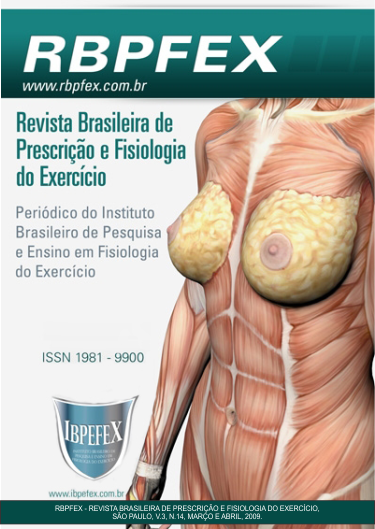Cardiorespiratory fitness of young women with deferments physical activity levels
Abstract
The cardiorespiratory fitness shows inverse correlation with morbi-mortality for cardiovascular diseases (CVD). Physical exercise has been recommended for prevention, being necessary adequate prescription. The aim of this study was analyze functional cardiorespiratory parameters in young women with different physical activity levels, stratify them and generate specifics orientations for exercise prescription. Fifty one cardiopulmonary tests of young women (20-34 years) – matched for age (± 2 years) and BMI (± 1 kg/m2) was analyzed, differentiating itself only in physical activity level: active versus sedentary group. The active group shows better indexes of maximal oxygen uptake – VO2max (40.0 ± 5.1 vs. 31,9 ± 5.4; p-value < 0,001) and percentage of VO2max in first (65.1 ± 7.2 vs. 60.3 ± 8.8; p-value = 0.03) and second (84.4 ± 5.7 vs. 79.3 ± 7.7; p-value = 0.01) ventilators threshold. It was observed a correlation between physical activity level and cardiorespiratory fitness (p-value < 0,001), with 87.5% of active women distributed between good and excellent capacity and 74.1% of sedentary group between weak and regular condition. According to results, it’s possible to conclude that active women show better cardiorespiratory fitness and reached ventilatory thresholds in higher relative load effort.
References
- Rosamond, W.; e colaboradores. Heart Disease and Stroke Statistics - 2007 Update: A Report From the American Heart Association. Circulation. 2007; 115:68-172.
- I Diretriz Brasileira sobre Prevenção de Doenças Cardiovasculares em Mulheres Climatéricas e a Influência da Terapia de Reposição Hormonal (TRH) da Sociedade Brasileira de Cardiologia (SBC) e da Sociedade Brasileira do Climatério (SOBRAC). Arq. Bras. Cardiol. 2008; 91(1):1-23.
- Haddad, N.; Silva, M.B. Mortalidade feminina em idade reprodutiva no Estado de São Paulo, Brasil, 1991-1995: causas básicas de óbito e mortalidade materna. Rev. Saúde Pública 2000; 34(1):64-70.
- Passos, L.; e colaboradores. Por que a Letalidade Hospitalar do Infarto Agudo do Miocárdio é Maior nas Mulheres? Arq. Bras. Cardiol. 1998; 70(5):327-330.
- Department of Health and Human Services (DHHS). Physical Activity Guidelines Advisory Committee. Physical Activity Guidelines Advisory Committee Report, 2008. Washington, DC: U.S. Department of Health and Human Services, 2008.
- Erikssen, G.; e colaboradores. Changes in physical fitness and changes in mortality. Lancet. 1998; 352(9130):759-62.
- Lamonte, M.J.; e colaboradores. Cardiorespiratory fitness and coronary heart disease risk factors: the LDS Hospital Fitness Institute Cohort. Circulation. 2000; 102(14):1623-8.
- Haskell, W.; e colaboradores. Physical Activity and Public Health: Updated Recommendation for Adults from the American College of Sports Medicine and the American Heart Association. Med Sci Sports Exerc. 2007; 39(8):1423-34.
- Silva, R.B.; e colaboradores. Atividade física habitual e risco cardiovascular na pós-menopausa. Rev. Assoc. Med. Bras. 2006; 52(4):242-6.
- American College of Sports Medicine. ACSM’s Guidelines for exercise testing and prescription. 6 ̊ ed. Baltimore: Lippincott Williams and Wilkins, 2000.
- Serra, S. Considerações sobre ergoespirometria. Arq. Bras. Cardiol. 1997; 68(4):301-4.
- American Heart Association. Exercise standards for testing and training. A statement for healthcare professionals from the American Heart Association. Circulation. 2001; 104:1694-1740.
- American Thoracic Society; American College of Chest Physicians. ATS/ACCP Statement on cardiopulmonary exercise testing. Am J Respir Crit Care Med. 2003; 167(2):211-277.
- Masson, C.R.; e colaboradores. Prevalência de sedentarismo nas mulheres adultas da cidade de São Leopoldo, Rio Grande do Sul, Brasil. Cad. Saúde Pública 2005; 21(6):1685-94.
- Oguma, Y.; Shinoda-Tagawa, T. Physical activity decreases cardiovascular disease risk in women: review and meta-analysis. Am J Prev Med. 2004; 26(5):407-18.
- Kohl, H.W. 3rd. Physical activity and cardiovascular disease: evidence for a dose response. Med Sci Sports Exerc. 2001; 33(6 Suppl):S472-S483.
- Manson, J.E.; e colaboradores. Walking compared with vigorous exercise for the prevention of cardiovascular events in women. N. Engl. J. Med. 2002; 347(10):716-25.
- Manson, J.E.; e colaboradores. A prospective study of walking as compared with vigorous exercise in the prevention of coronary heart disease in women. N Engl J Med. 1999; 341(9):650-8.
- Matthews, C.E,; e colaboradores. Influence of exercise, walking, cycling, and overall nonexercise physical activity on mortality in Chinese women. Am J Epidemiol. 2007; 165(12):1343-50.
- Eskurza, I.; e colaboradores. Changes in maximal aerobic capacity with age in endurance-trained women: 7-yr follow-up. J Appl Physiol. 2002; 92(6):2303-08.
- Tanaka, H.; e colaboradores. Greater rate of decline in maximal aerobic capacity with age in physically active vs. sedentary healthy women. J Appl Physiol. 1997; 83(6):1947-53.
- Braga, A.M.F.W.; Nunes, N. Ergoespirometria aplicada à cardiologia. In: Negrão, C.E. e Barretto, A.C.P. Cardiologia do exercício: do atleta ao cardiopata. São Paulo: Manole, 2005.
Authors who publish in this journal agree to the following terms:
- Authors retain the copyright and grant the journal the right of first publication, with work simultaneously licensed under the Creative Commons Attribution License BY-NC which allows the sharing of the work with acknowledgment of the authorship of the work and initial publication in this journal.
- Authors are authorized to enter into additional contracts separately for non-exclusive distribution of the version of the work published in this journal (eg, publishing in institutional repository or book chapter), with acknowledgment of authorship and initial publication in this journal.
- Authors are allowed and encouraged to post and distribute their work online (eg, in institutional repositories or on their personal page) at any point before or during the editorial process, as this can bring about productive change as well as increase impact and impact. citation of published work (See The Effect of Free Access).






